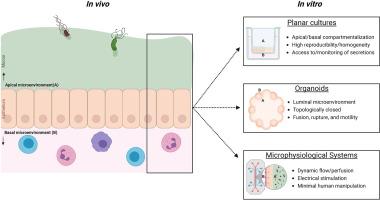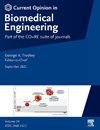研究细菌感染微环境的类器官和衍生模型
IF 4.2
3区 工程技术
Q2 ENGINEERING, BIOMEDICAL
引用次数: 0
摘要
感染的微环境是围绕病原体和宿主之间相互作用的生物空间。关注上皮屏障,根尖微环境对应于器官的管腔,病原体必须在体液、微生物群和细胞分泌物中生存。另一方面,基底微环境包括基质细胞、血管内皮细胞和对抗感染的免疫细胞。顶域和基域之间的第一个区别是上皮本身,上皮由极化细胞组成,它们向顶域和基域分泌不同的分子。类器官和其他干细胞衍生的培养系统已经成为研究上皮屏障及其病原体识别、炎症信号和分化能力的有价值的模型。通过在体外模拟上皮生物学的多个方面,类器官提供了一个机会来研究从最初的攻击到随后的防御的感染。这篇综述探讨了类器官、干细胞衍生的平面培养和微生理系统如何改变我们对感染微环境的理解。本文章由计算机程序翻译,如有差异,请以英文原文为准。

Organoids and derived models to study the microenvironments of bacterial infections
The microenvironment of an infection is the biological space surrounding the interaction between the pathogen and the host. Focusing on epithelial barriers, the apical microenvironment corresponds to the lumen of the organ, where the pathogen must survive amidst body fluids, microbiota, and cellular secretions. On the opposite side, the basal microenvironment includes stromal cells, endothelial cells of blood vessels, and immune cells recruited to combat infection. The first distinguishing element between the apical and basal domains is the epithelium itself, which consists of polarized cells that secrete different molecules to their apical and basal domains. Organoids and other stem cell-derived culture systems have emerged as valuable models for studying epithelial barriers and their capacities for pathogen recognition, inflammatory signalling, and differentiation. By mimicking multiple aspects of epithelial biology in vitro, organoids provide an opportunity to investigate infections from the initial attack to the subsequent defences. This review explores how organoids, stem cell-derived planar cultures, and micro-physiological systems are transforming our understanding of infection microenvironments.
求助全文
通过发布文献求助,成功后即可免费获取论文全文。
去求助
来源期刊

Current Opinion in Biomedical Engineering
Medicine-Medicine (miscellaneous)
CiteScore
8.60
自引率
2.60%
发文量
59
 求助内容:
求助内容: 应助结果提醒方式:
应助结果提醒方式:


